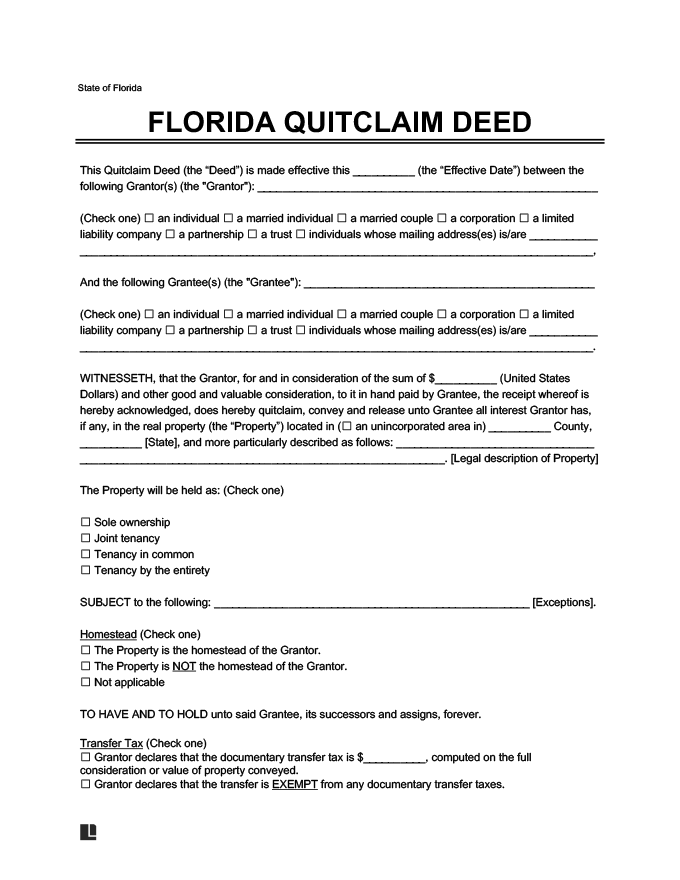A quitclaim deed in Florida allows for the faster, easier transfer of properties between two entities or individuals: the grantor (the party selling or giving the property) and the grantee (the party receiving the property).
Because quitclaim deeds do not convey warranty protections that are essential in many real estate transactions, they are typically used to transfer property between individuals who know one another, to a spouse to a title, or to manage the transfer of assets following a divorce.
Legal Framework
Chapter 689 and Chapter 695 of the Florida Statutes cover the quitclaim deed requirements. Fla. Stat. § 689.025 lays out sample language for a quitclaim deed. While this language does not have to be used precisely, it does provide a clear format and content guidelines for the document.
Legal Description
- A blank space should be provided for the parcel identification number assigned to the property, which should be entered if it is available before recording. However, the absence of this number doesn’t affect the deed’s validity or recordability (Fla. Stat. § 689.02).
- State law only explicitly addresses lot and block descriptions in Fla. Stat. § 177.021 (Legal status of recorded plats) and condominium parcels in Fla. Stat. § 718.109 (Legal description of condominium parcels).
- Including a description in a conveyance instrument renders it a legal description according to general legal practice. It needs to be legibly printed, typewritten, or stamped on the deed.
Signing
- According to Fla. Stat. § 689.01 and Fla. Stat. § 695.26, a quitclaim deed must be signed by the grantor in the presence of a notary public and two witnesses in order to be considered valid.
Terminology
- There are no specific statutory requirements for the language to be used in a quitclaim deed.
Additional Documents
Whether you need to file additional documents with your quitclaim deed will depend on the individual county where the form is submitted. In Florida, each county can set its own requirements, which may include:
- Providing a self-addressed, stamped envelope for the return of the completed deed.
- A Property Transfer Information Form.
Consult your appropriate county clerk’s office to determine the specific requirements.
Filing
- Once signed and notarized, all forms should be filed with the Clerk of County Court where the property is located.
Validity Requirements
A valid quitclaim deed in Florida must follow the same requirements as other deeds for formatting and submission:
- A blank space in the top right corner measuring at least 3 x 3 inches, according to Fla. Stat. § 695.26.
- Margins of at least 1 inch on all sides.
There aren’t any specific requirements for the paper size of submitted documents. However, if the paper is larger than the standard legal size (8 1/2 x 14″), Fla. Stat. § 28.24 notes that additional fees may be charged.
Content Requirements
Fla. Stat. § 689.025 establishes the basic formatting and requirements for quitclaim deeds. These include:
- The date of the property transfer.
- The name and address of the grantor.
- The name and address of the grantee.
- A legal description of the property.
- The funds or other consideration paid for the property.
A quitclaim deed that does not contain all relevant information may not be considered valid, which may mean that you have to go back and resubmit.
Quitclaim Deeds vs. Other Property Transfer Methods
| Quitclaim Deed | Warranty-free property transfer method; avoids the need for complicated disclosures. Does not give the new owner legal rights if a lien or problem with the property is discovered. May require them to take out title insurance for additional protection. |
| General Warranty Deed | Provides full warranty of title protection; typically used in real estate transactions when the parties do not know one another. Slower property transfer method; may ultimately prove more expensive. |
| Special Warranty Deed | Guarantees the current owner of the property does not know about any liens or title issues. Does not convey full warranty protection to the new owner of the property, which can cause some issues. |
| Life Estate Deed | Creates two interests in a property: the life interest, which allows the current property owner to own and use the property as they see fit during their lifetime, and the remainder interest, which allows the new owner to take over the property after the death of the current owner. |
| Lady Bird Deed | Sometimes called an enhanced life estate deed, does not go into effect until the current owner dies; provides no recourse for the grantee if the grantor changes their mind or mortgages or sells the property. |
